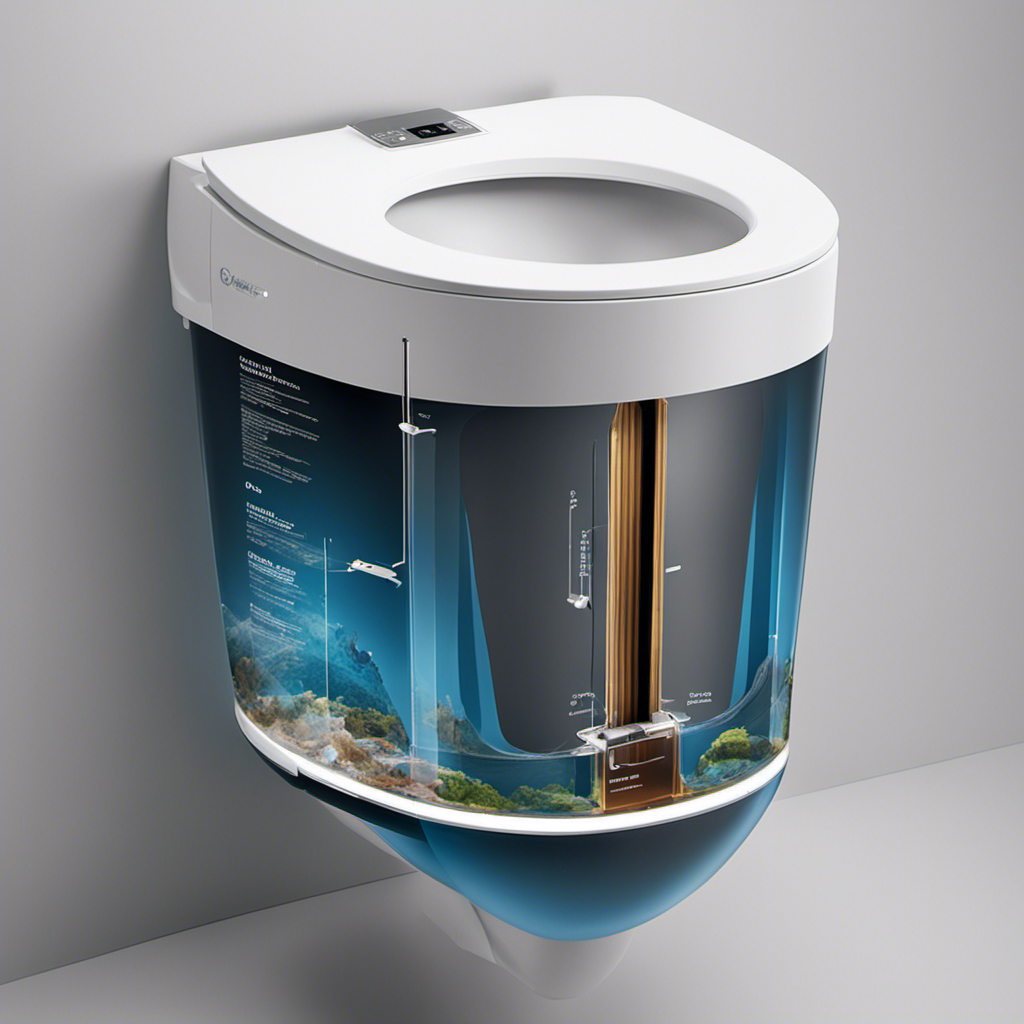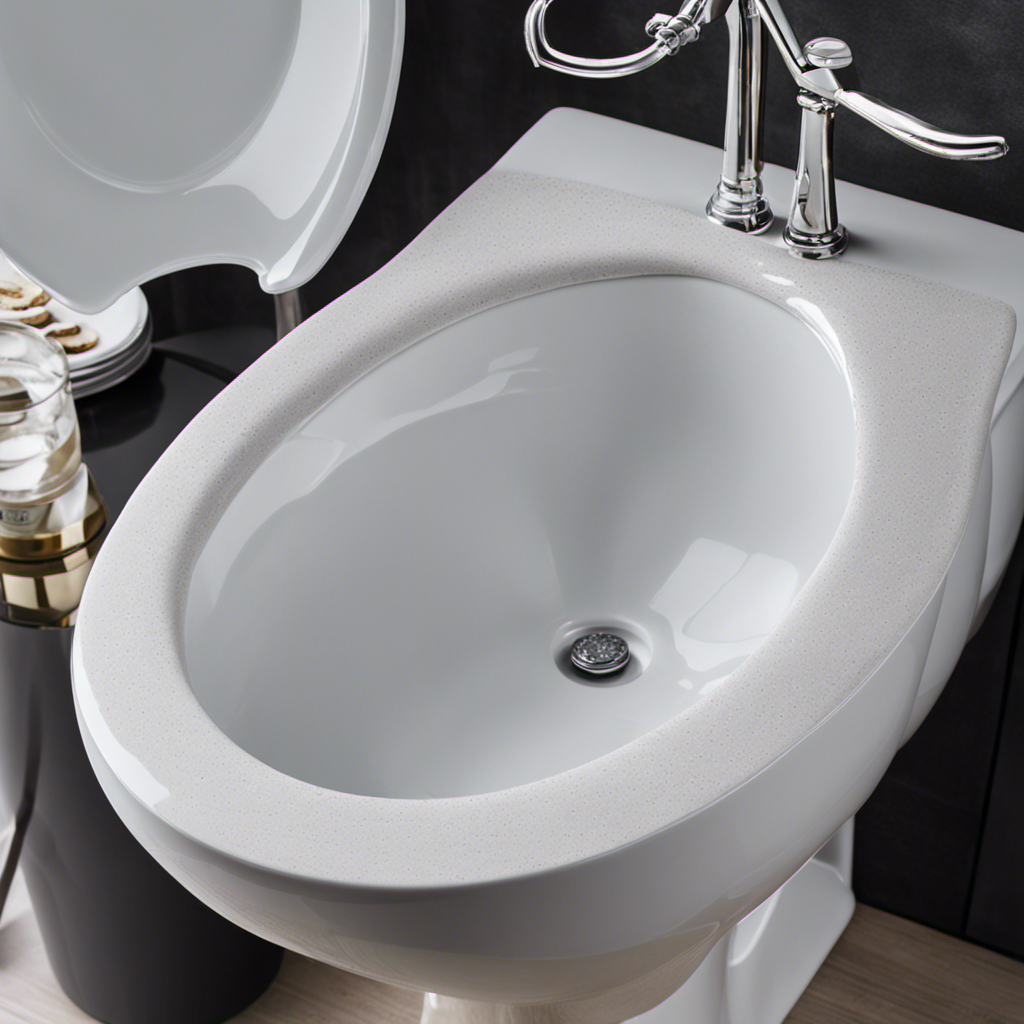I’ve learned that optimizing water levels for efficient toilet flushing is crucial for conserving water and ensuring proper functionality.
Did you know that federal standards dictate toilets should use no more than 1.6 gallons of water per flush? Maintaining the right water level, just above the P-trap outlet, is key to effective flushing.
By measuring the water surface area and making adjustments to the ball float or cylinder float, we can achieve optimal water levels.
Let’s dive into the details of this important topic.
Key Takeaways
- Federal standards dictate that a toilet should use no more than 1.6 gallons of water per flush.
- The water level should be right above the toilet’s P-trap outlet to ensure proper suction for flushing.
- The amount of water can vary depending on the toilet’s shape and size, but is typically about 1.6 gallons or 6 liters per flush.
- To increase the water level in the toilet bowl, check for clogs in the pipes or a blocked vent, pour hot water into the bowl to increase pressure, plunge the toilet or use an auger, or adjust the ball float or cylinder float.
Federal Standards for Water Usage
According to federal standards, I should ensure that my toilet uses no more than 1.6 gallons of water per flush. These standards are in place to promote water conservation and limit water consumption.
By adhering to these guidelines, we can contribute to the overall effort of conserving water resources. It is important to be mindful of the amount of water we use for flushing, as excessive water consumption can strain our water supply and have negative environmental impacts.
Therefore, it is crucial to optimize the water levels in our toilets to meet the specified water consumption limits. This can be achieved by adjusting the ball float or cylinder float, as well as addressing any issues that may cause the water level to be too low or too high.
Importance of Proper Water Level
In my experience, maintaining the proper water level in the toilet bowl is crucial for effective flushing. Not only does it ensure that waste is properly evacuated, but it also contributes to water conservation efforts. The impact of water level on flushing efficiency cannot be overstated. When the water level is too low, it can lead to incomplete flushing and the need for multiple flushes, wasting water in the process. On the other hand, if the water level is too high, it can lead to unnecessary water usage. By finding the optimal water level, we can strike a balance between efficient flushing and water conservation. By doing so, we can contribute to a more sustainable and environmentally-friendly approach to toilet usage.
| Importance of Water Conservation | Impact of Water Level on Flushing Efficiency |
|---|---|
| Minimizes water waste | Ensures complete waste evacuation |
| Reduces the need for multiple flushes | Prevents unnecessary water usage |
| Contributes to sustainability | Promotes efficient toilet operation |
Measuring Water Surface Area
When measuring the water surface area in the toilet bowl, I often refer to the provided measurements on the packaging or in the owner’s manual. Calculating the water volume accurately is crucial for optimizing flushing power.
Here are three key points to consider:
-
Water level impact: The water level in the toilet bowl directly affects the flushing power. If the water level is too low, it may not provide enough force to effectively flush waste. On the other hand, if the water level is too high, it can cause water to overflow or create unnecessary splashing.
-
Proper suction: To ensure proper suction for flushing, the water level should be right above the toilet’s P-trap outlet. This position allows for the optimal flow of water and waste removal.
-
Manufacturer-provided measurements: The surface area of the water in the toilet bowl can be determined by the length and width measurements provided by the manufacturer. These measurements are crucial for calculating the water volume accurately and ensuring efficient flush performance.
Troubleshooting Low Water Levels
I often troubleshoot low water levels in the toilet bowl by checking for clogs or blockages in the pipes. Unclogging pipes is essential for maintaining proper water levels and efficient flushing.
To troubleshoot odors, I investigate the possibility of a blocked vent, which can cause gurgling noises and unpleasant smells. Clearing the blockage by filling the vent with water or using a sewer auger can alleviate these issues.
Additionally, pouring a large bowl of hot water into the bowl can increase pressure and unclog the pipe. Plunging the toilet or using an auger are also effective methods for unclogging pipes.
Adjusting the Ball Float
To fix a low water level in the toilet bowl, you can adjust the ball float by tightening the screw in a clockwise direction. This adjustment will increase the water level and ensure optimal flushing performance.
Here are three reasons why adjusting the ball float is beneficial:
-
Water Conservation: By increasing the water level, you can ensure that the toilet flushes efficiently, using the appropriate amount of water. This helps in conserving water and reducing water wastage.
-
Preventing Clogs: A low water level in the toilet bowl can lead to inadequate flushing, resulting in frequent clogs. By adjusting the ball float, you can maintain the correct water level, preventing clogs and the need for costly repairs.
-
Improved Flushing Power: When the water level is too low, flushing power is compromised, leading to incomplete waste removal. By adjusting the ball float, you can optimize the water level and ensure a strong and effective flush every time.
Adjusting the Cylinder Float
Adjusting the cylinder float can be done by pinching the release clip and raising it up to increase the water level in the toilet bowl.
If you are experiencing high water levels in your toilet bowl, troubleshooting the issue is crucial. One common cause of high water levels is a malfunctioning cylinder float.
By adjusting the cylinder float, you can effectively control the water level. Increasing the water pressure may also help in troubleshooting high water levels.
To do this, you can check for clogs in the pipes or a blocked vent. Pouring hot water into the bowl or using a plunger or auger can help unclog the pipe.
If the issue persists, filling the vent with water or using a sewer auger may clear the blockage.
Tips for Efficient Toilet Flushing
One tip for improving the flush of my toilet is to ensure the water level is right above the P-trap outlet. This is important because the water level affects the toilet water pressure, which directly impacts the efficiency of the flush.
Here are three benefits of maintaining high water levels in the toilet:
-
Increased flushing power: With a higher water level, there is more force exerted on the waste, resulting in a more powerful flush that can effectively remove solid waste and prevent clogs.
-
Better cleaning: The higher water levels ensure that the entire bowl is cleaned thoroughly with each flush, reducing the chances of stains and odors.
-
Improved hygiene: High water levels create a larger water surface area, which helps to minimize contact between waste and the bowl, leading to better hygiene and a cleaner toilet.
Frequently Asked Questions
Can the Water Level in a Toilet Bowl Be Too High?
Yes, the water level in a toilet bowl can be too high. Pros of high water levels include better flushing power, but cons include increased risk of overflow and splashing. High water levels can also affect toilet bowl cleanliness.
How Can a Blocked Vent Affect the Water Level in a Toilet Bowl?
A blocked vent can affect the water level in a toilet bowl by causing gurgling noises and unpleasant odors. Filling the vent with water or using a sewer auger can clear the blockage.
What Are Some Common Causes of Clogs in the Pipes That Can Lead to a Low Water Level in the Toilet Bowl?
Toilet clogs and pipe blockages are common causes of low water levels in the bowl. Clogs can occur from debris, foreign objects, or a build-up of waste. Clearing the pipes can help restore proper water flow.
Are There Any Risks or Potential Issues Associated With Adjusting the Ball Float or Cylinder Float to Increase the Water Level?
Adjusting the ball float or cylinder float to increase water levels in the toilet bowl can lead to risks and potential issues. Improper adjustment can cause overflow, damage to the toilet, and inefficient flushing.
Is There a Recommended Water Level Range for Optimal Toilet Flushing Efficiency?
The recommended water level range for optimal toilet flushing efficiency is crucial. It ensures proper suction and effective flushing. Maintaining the correct water level in toilets is important for efficient operation and preventing potential issues.
Conclusion
In conclusion, optimizing water levels for efficient toilet flushing is crucial for conserving water and ensuring proper functionality. By adhering to federal standards and measuring the water surface area, we can determine the ideal water level for effective flushing.
Troubleshooting low water levels, such as addressing clogs or adjusting the ball or cylinder float, can resolve any issues. Implementing these adjustments will enhance the flushing efficiency and minimize water wastage.
Remember, a well-adjusted toilet is like a well-oiled machine, smoothly and effortlessly getting the job done.










